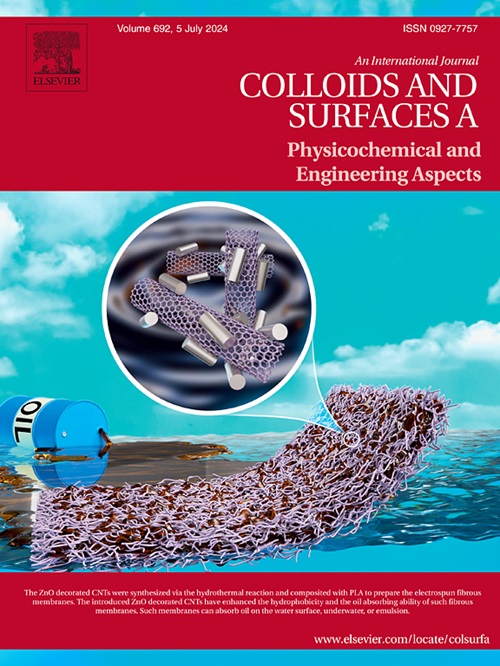基于丝纤维素和四聚体接枝聚乙烯亚胺胶束的三维打印导电水凝胶,用于人体运动监测
IF 4.9
2区 化学
Q2 CHEMISTRY, PHYSICAL
Colloids and Surfaces A: Physicochemical and Engineering Aspects
Pub Date : 2024-10-29
DOI:10.1016/j.colsurfa.2024.135671
引用次数: 0
摘要
导电水凝胶因其仿生结构、固有特性和生物相容性而具有独特的优势,在柔性可穿戴设备、软机器人、植入式设备和其他领域的应用前景十分广阔。本研究以我们之前的研究为基础,通过 30% Pluronic F127 和苯胺四聚体接枝聚乙烯亚胺(AT-PEI)共聚物的组合,制造出一种导电水凝胶。为了增强水凝胶的性能,我们利用 F127 和 AT-PEI/DNA 复合物(AD)诱导蚕丝纤维素从无规线圈结构转变为β片状结构,成功地设计出了基于蚕丝纤维素的导电水凝胶(SF-AD),赋予了水凝胶离子和电子双重导电性。所有水凝胶的电导率都超过了 10-4 S/cm。此外,扫描电子显微镜还对水凝胶的孔径进行了表征,结果表明随着 AD 含量的增加,水凝胶的孔径会减小。水凝胶的溶胀率介于 4.89 和 6.50 之间,表明水凝胶的结构具有可调性。利用三维打印技术,我们制作出了 2 × 2 平方厘米的网格活性导电层,确保了更均匀的应力分布--网格宽度为 4 毫米时灵敏度最高。我们组装的水凝胶传感器在超过 1000 次的循环测试中表现出了长期稳定性,并证明能够识别人类的各种动作。SF-AD 水凝胶具有独特的特性组合和定制潜力,在柔性电子领域的应用前景十分广阔。本文章由计算机程序翻译,如有差异,请以英文原文为准。
3D printed conductive hydrogel based on silk fibroin and tetramer-grafted-polyethylenimine micelle for body-motion monitoring
Conductive hydrogels hold significant promise for applications in flexible wearable, soft robotics, implantable devices, and other fields, which offer distinct advantages due to their biomimetic structures, intrinsic properties, and biocompatibility. This study builds upon our previous research by fabricating a conductive hydrogel through the combination of 30 % Pluronic F127 and aniline tetramer-grafted-polyethyleneimine (AT-PEI) copolymers. To enhance the properties of hydrogels, we successfully engineered silk fibroin-based conductive hydrogels (SF-AD) by inducing the transition of silk fibroin from a random coil to a β-sheet structure using the F127 and AT-PEI/DNA complex (AD), endowing the hydrogels with dual ionic and electronic conductivity. The conductivity of all hydrogel exceeds 10−4 S/cm. Additionally, SEM was employed to characterize the pore size of the hydrogels, revealing a decrease with higher AD content. The swelling ratio ranged between 4.89 and 6.50, indicating the tunable nature of the hydrogels' structure. Utilizing 3D printing, we produced a 2 × 2 cm2 mesh active conductive layer that ensures a more uniform stress distribution—maximum sensitivity with a grid width of 4 mm. Our assembled hydrogel sensor demonstrated long-term stability in cycling tests over 1000 cycles and proved capable of recognizing various human movements. The SF-AD hydrogel, characterized by its unique combination of properties and potential for customization, presents broad prospects for future applications in flexible electronics.
求助全文
通过发布文献求助,成功后即可免费获取论文全文。
去求助
来源期刊
CiteScore
8.70
自引率
9.60%
发文量
2421
审稿时长
56 days
期刊介绍:
Colloids and Surfaces A: Physicochemical and Engineering Aspects is an international journal devoted to the science underlying applications of colloids and interfacial phenomena.
The journal aims at publishing high quality research papers featuring new materials or new insights into the role of colloid and interface science in (for example) food, energy, minerals processing, pharmaceuticals or the environment.

 求助内容:
求助内容: 应助结果提醒方式:
应助结果提醒方式:


